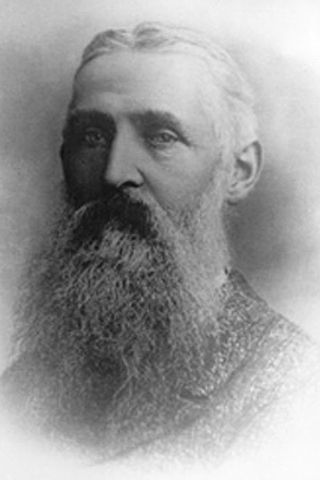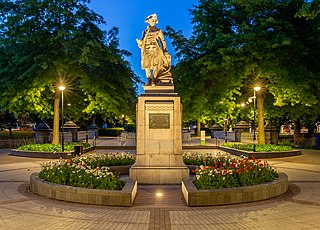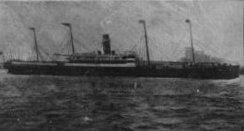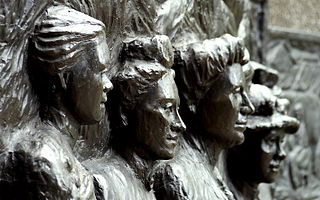
Katherine Wilson Sheppard was the most prominent member of the women's suffrage movement in New Zealand and the country's most famous suffragist. Born in Liverpool, England, she emigrated to New Zealand with her family in 1868. There she became an active member of various religious and social organisations, including the Women's Christian Temperance Union New Zealand. In 1887 she was appointed the WCTU NZ's National Superintendent for Franchise and Legislation, a position she used to advance the cause of women's suffrage in New Zealand.

Springfield, called Kowai Pass until 1880, is a small town in the Selwyn District of Canterbury, in the South Island, of New Zealand. Springfield is situated in the foothills of the Southern Alps as the most westerly town of the Canterbury Plains. Springfield is 65 kilometres (40 mi) west of Christchurch on State Highway 73, 9.7 kilometres (6.0 mi) northwest of Sheffield and 22.7 kilometres (14.1 mi) from Darfield. It is located close to Porters Ski Area, Mount Cheeseman, Broken River, Temple Basin and Craigieburn ski fields. Springfield has a long association with the Midland railway line.

Christchurch Girls' High School in Christchurch, New Zealand, was established in 1877 and is the second oldest girls-only secondary school in the country, after Otago Girls' High School.

Sir William Jukes Steward was a New Zealand politician and the first Liberal Speaker of the New Zealand House of Representatives. He represented South Canterbury electorates in Parliament for a total of 34 years, before being appointed to the Legislative Council. He served briefly on the Otago Provincial Council and was Mayor of Oamaru for three years.
The following lists events that happened during 1897 in New Zealand.

Margaret Barnett Cruickshank was a New Zealand medical practitioner who died during the 1918 influenza pandemic. She was the first registered female doctor in New Zealand. Posthumously, she was the first woman, other than Queen Victoria, to have a monument erected to her in New Zealand.

The Citizens' War Memorial in Cathedral Square, Christchurch, is one of the two major memorials in the city to World War I. It is located immediately north of ChristChurch Cathedral. The annual Anzac Day service was held there until the February 2011 earthquake; since then the memorial has been behind the fence around the cathedral. It is a Category I heritage structure registered with Heritage New Zealand. Between 2021 and 2022, the memorial was repaired and shifted 50 metres (160 ft) to the west. The Citizens' War Memorial was used for the 2023 ANZAC day dawn service in Christchurch.

William Thomas Trethewey was a sculptor and monumental mason from Christchurch, New Zealand. His best known work is the Citizens' War Memorial in Cathedral Square, Christchurch, where the city's annual Anzac Day service is held.

The Bridge of Remembrance is one of two main war memorials in Christchurch, New Zealand. It is dedicated to those who died in World War I, and serves as a memorial for those who participated in two World Wars as well as subsequent conflicts in Borneo, Korea, Malaya, and Vietnam. Owned by Christchurch City Council, it is located on the Cashel Street Bridge at the head of City Mall. The Bridge of Remembrance was repaired and strengthened following the 2011 Christchurch earthquake and was reopened with a rededication ceremony held on Anzac Day in 2016.

The Cook Statue in Victoria Square, Christchurch, commemorates the three journeys of James Cook to New Zealand. The statue, sculpted by William Trethewey, was unveiled on 10 August 1932 by the Governor-General, Lord Bledisloe. It was donated by bookmaker and philanthropist Matthew Barnett (1861–1935).
Daisy Elizabeth Platts-Mills was a New Zealand medical doctor and community leader. She was the first woman medical doctor in private practice and served on numerous community organisations, particularly those concerned with the health and welfare of women and children.
Margaret Home Sievwright was a New Zealand feminist, political activist and community leader. She was particularly active in the temperance and suffrage movements, and became president of the National Council of Women of New Zealand.
Waimate is a town in Canterbury, New Zealand and the seat of Waimate District. It is situated just inland from the eastern coast of the South Island. The town is reached via a short detour west when travelling on State Highway One, the main North/South road. Waimate is 45.7 km south of Timaru, Canterbury's second city, 20 km north of the Waitaki River, which forms the border between Canterbury and the Otago province to the south and 47.5 km north of Oamaru, the main town of the Waitaki District.

SS Marquette was a British troopship of 7,057 tons which was torpedoed and sunk in the Aegean Sea 36 nautical miles (67 km) south of Salonica, Greece on 23 October 1915 by SM U-35, with the loss of 167 lives.

The Kate Sheppard National Memorial, located in the city of Christchurch, is New Zealand's first memorial to the women's suffrage campaign, and particularly honours the life of one of the country's leading campaigners for women's suffrage, Kate Sheppard.
Bernice Elizabeth Shackleton was a New Zealand journalist and writer.

Isabel Clark was a New Zealand nurse who served in the First World War and died when the SS Marquette was torpedoed and sunk in 1915.

Margaret Rogers was a New Zealand nurse who served in the First World War and died when the SS Marquette was torpedoed and sunk in 1915.

William Henry Feldon was a sculptor, architectural sculptor, and monumental mason from Oxford, England who migrated to New Zealand in 1910. He is best known for his series of First World War memorials—where annual Anzac Day services are held—and his contributions to iconic public buildings in New York, New Zealand, and England.
Okaiawa or Ōkaiawa is a rural community in South Taranaki, New Zealand. It is located about 14 kilometres north-west of Hāwera, north of State Highway 45 and State Highway 3. The settlement is located south-east of Mount Taranaki, close to Inaka River.















